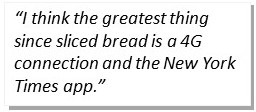Full disclosure: I think the greatest thing since sliced bread is a 4G connection and the New York Times app.
When I first became ill and before I was diagnosed with rheumatoid arthritis, reading became difficult. It just plain hurt to hold a simple paperback, and any weighty tome was certainly out of the question. Yet, I was fatigued and in pain; I liked to lie in bed a lot, but I didn’t own a television. eBooks and online versions of my favorite periodicals were a godsend because I could read them on my smartphone–it was lightweight and easy to manage. Plus, scrolling was actually easier than turning pages.
 Obviously, I spend a great deal of time in doctors’ offices. Since they’re doctors’ offices, I almost always end up waiting, and waiting, and waiting. I don’t particularly care for hack-written, health-oriented, pharmaceutical-selling magazines, nor am I fond of Golf Digest. And I get bored easily because I’m the type of person who would read a cereal box if I had nothing else in front of me. Therefore, when the capability to read The Guardian and The New York Times (not to mention The Atlantic and a few other publications) on my cell phone came along, I was ecstatic. I could have meaningful (and often long form) content at my finger tips anywhere I went, especially the doctor’s waiting room.
Obviously, I spend a great deal of time in doctors’ offices. Since they’re doctors’ offices, I almost always end up waiting, and waiting, and waiting. I don’t particularly care for hack-written, health-oriented, pharmaceutical-selling magazines, nor am I fond of Golf Digest. And I get bored easily because I’m the type of person who would read a cereal box if I had nothing else in front of me. Therefore, when the capability to read The Guardian and The New York Times (not to mention The Atlantic and a few other publications) on my cell phone came along, I was ecstatic. I could have meaningful (and often long form) content at my finger tips anywhere I went, especially the doctor’s waiting room.
Therefore, I sometimes think that the debate over the efficacy of digital and print forms starts with the wrong question. Instead, I think we should be asking, “Can digital formats increase access to texts, especially for those who wouldn’t otherwise have access?” I’ve returned over and over again to my own literacy experiences in ENG-W682. Again, based on those experiences I have to say, “Yes, digital reading has increased access to texts, and that’s a very good thing.”
I know I’m not alone. A study published just last month in the journal Eye found that iPads, like other much bulkier magnification devices, can increase reading speeds by 200% for low-vision patients (Morrice, et al.). Similarly, I wasn’t surprised when Alsalem found that 28 percent of teachers reported that “digital literacy accommodates different types of diverse students’ needs” (210). Interestingly, 7% of the teachers in the study also noted that digital technology also made students with disabilities more independent (Alsalem 210).
In their call for a broader definition of literacy, Keefe and Copeland note “the lack of literacy access and opportunities for students with disabilities, particularly those with extensive needs for support” has only recently begun to receive the serious attention. The National Center on Deaf-Blindness emphasize that literacy is a human right, meaning that people “regardless of the extent or severity of their disabilities, have the basic right to use print.” Therefore, such students have “The right to have accessible, clear, meaningful, culturally and linguistically appropriate texts at all time.” If e-reading technology expands access to literacy in anyway, then I say we should embrace it and not fear it.
Granted, the scholarship is clear that reading digital texts is not free of problems. As Jabr notes, studies have consistently shown that digital reading does not provide the retention that print reading does; it can also cause more stress. To a certain extent, I also agree with Schreiner that something magical happens when humans make meaning out of difficult literature: “Its difficulty involves the reader in a meaning-making process that forces personal involvement, something sorely lacking from information retrieval.” I also definitely understand the need to annotate a difficult text to help with meaning. However, if people really need alternate forms–and a digital text can provide that form–people will adjust.
I have a friend, Fred Wurtzel, who is one of the most capable people that I know. Fred is also blind. He listens to a great many audiobooks and can relay the details and explicate the themes as well as any literature major. Therefore, I can only conclude that it is not the medium; it’s the person and the skills they employ. Since Fred lost his sight as a teenager, he had to adjust–just like the whole world is now adjusting to digital texts. His wife Mary is a Braille reader. She can’t take notes in the margin because she needs her fingers to read, but she holds a Master’s Degree from the University of Michigan. For her, text is always scrolling in a way. Readers who cannot perceive text printed on a paper can develop the cognitive skills to fully understand and remember written communication. In a world of digital writing, all readers can learn to do the same. The proverbial genie has been let out of the bottle, and teachers of literacy skills need to adjust. We need to research methods to make the most out of digital texts, develop pedagogy that helps readers navigate both print and digital texts, and design courses that privilege neither medium.
My commitment to the coexistence of print and digital literacies is what made Hayles’ piece one of my favorites this semester. When she argues for exploring “the interrelations between the components of an expanded repertoire of reading strategies that includes close, hyper, and machine reading” (74), I could not agree more. When Hayles discussed how she had students read both Mary Shelley’s Frankenstein and Shelley Jackson’s Patchwork Girl, I began seeing the possibilities for my own class. I want to pick a print book and digital texts and teach students the value of ctrl + f to supplement their understanding.

Because even in the future, Captain Picard will read actual print books, I’d like to claim fair use for educational purposes in using this picture from Paramount Television.
And by the way, it’s not our students–Gen Y and Gen Z–who have problems crossing platforms. It’s us. Over 1.8 million people (mostly teenagers) have downloaded Hooked, an app that sends a mystery novel to phones in the form of text messages (Ha). Moreover, according to the Pew Research Center millennials are out-reading their older counterparts. More importantly, they are still more likely to read print books, even if they read more eBooks than older generations (Perrin). I truly believe that if we want students to know the struggle and joy that is deep literary reading, then we’re the ones who need to alter our reading habits so that we can truly help them navigate the advanced literacies we want them to have. It is only when we embrace the different ways that text is coming at us in the 21st century, that we can find a way to teach students to consume them effectively.
Works Cited
Alsalem, Majed A. “Redefining Literacy: The Realities of Digital Literacy for Students
with Disabilities in K-12.” Journal of Education and Practice 7.32 (2016): 205-215. ERIC. Web. 28 Feb. 2017.
Ha, Thu-Huong. “American Teens Are Getting Hooked on Fiction by Text Message.” Quartz. Quartz, 1 Dec. 2016. Web. 2 Mar. 2017. https://qz.com/847350/hooked-book-app-vs-kindle-and-audible-us-teen-readers-are-getting-hooked-on-fiction-by-text-message/
Hayles, Katherine M. “How We Read: Close, Hyper, Machine.” ADE Bulletin 150 (2010): 62-79. Web. 28 Feb. 2017. http://nkhayles.com/how_we_read.html
Jabr, Ferris. “The Reading Brain in the Digital Age: The Science of Paper versus Screens.” Scientific American. Scientific American, 11 Apr. 2013. Web. 28 Feb. 2017. https://www.scientificamerican.com/article/reading-paper-screens/
Keefe, Elizabeth B. and Susan R. Copeland. “What is Literacy? The Power of a Definition.” Research and Practice for Persons with Severe Disabilities 36.3-4 (2001). Sage Journals. Web. 2 Mar. 2017.
“Literacy Bill of Rights.” Literacy for Children with Combined Vision and Hearing Loss. National Center on Deaf-Blindness, n.d. http://literacy.nationaldb.org/index.php/literacy-bill-rights/
, E.,
Perrin, Andrew. Book Reading 2016. Pew Research Center, 1 Sept. 2016. Web. 2 Mar. 2017. http://www.pewinternet.org/2016/09/01/book-reading-2016/
Schreiner, Christopher S. “Scanners and Readers: Digital Literacy and the Experience of Reading.” Technology and Diversity in Higher Education: New Challenges. Yukiko Inoue, ed. Hershey, PA: Information Science Publishing, 2007. 1-23. Gale Virtual Reference Library. Web. 28 Feb. 2017.
